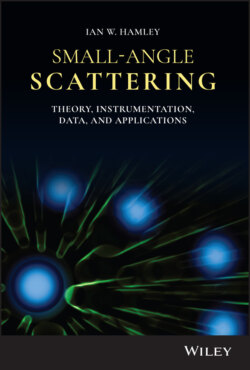Читать книгу Small-Angle Scattering - Ian W. Hamley - Страница 22
1.6.5 Fractal Structures
ОглавлениеA number of structure factors have been proposed for fractal structures. For these systems, the separation of form and structure factors often does not make sense; therefore, we denote the scattering just by the intensity. One model commonly used in the analysis of SAS data is the Fischer–Burford fractal model, for which the structure factor is given by [32, 33]
(1.61)
where I0 is the forward scattering intensity, D is the fractal dimension, and Rg is the radius of gyration of the aggregate.
Another widely employed expression is that for the structure factor of a mass‐fractal: [33–36]
(1.62)
where I0 denotes forward scattering, D is the fractal dimension, and ξ is the correlation length.
Another widely used model was developed by Beaucage for a variety of systems with ordering on multiple length scales including fractal structures, and is based on an expression for the scattering from excluded volume polymer fractals [37, 38]. This gives a function that interpolates between a Guinier function at low q and a Porod function at high q. It is used for many types of systems, such as porous materials (Section 5.11), colloidal and gel aggregate structures, polymer foams, polymer nanocomposites, nanopowders, and other systems. The unified Beaucage expression for a system with one structural level is [39]:
(1.63)
Here G is a Guinier scaling factor, Rg is the radius of gyration of the mass fractal object, P is a Porod constant, D is the fractal dimension, and erf denotes the error function. The constant P is related to G via the expression [38]:
(1.64)
Here Γ(D/2) denotes a Gamma function. Analytical expressions are available for G and P for a variety of uniform particles with different shapes as well as types of polymers [40].
Figure 1.12 shows an example of a fit to USAXS data for a titania nanopowder, along with indicated contributions from the Guinier and Porod components of Eq. (1.64).
Figure 1.12 Example of fitting of SAS data using the unified Beaucage model, Eq. (1.63), to fit USAXS data for a titania nanopowder (inset: TEM image). The contributions from the Guinier and Porod components of Eq. (1.63) are shown. Also shown for comparison is the limiting Porod slope in a scattering profile from spheres of the same radius of gyration Rg as from the Beaucage model fit.
Source: From Beaucage et al. [40]. © 2004, International Union of Crystallography.
A generalized Beaucage function is used for a system with two structural levels with radius of gyration Rg for the fractal and Rsub for the subunits [41]
(1.65)
Here k is an empirical constant, k ≈ 1 [41], and Gs, Ps are the Guinier and Porod scaling terms for the subunit components of the intensity, ds is the fractal dimension for the subunits with size Rs, and P and D are as defined in Eqs. (1.63) and (1.64). This function has a large number of parameters and can be used to fit SAS data from many multilevel systems. Figure 1.13 shows an example of a calculated generalized Beaucage form factor along with the components corresponding to the corresponding terms in Eq. (1.65).
Figure 1.13 Example of calculated form factor using the generalized Beaucage form factor, Eq. (1.65) along with the components of this equation. Calculation for G = 1, P = 1 × 10−4, Gs = 5 × 10−3, Ps = 1 × 10−5, Rg = 50 Å, Rsub = 30 Å, Rs = 10 Å, k = 1, ks = 1, D = 4, Ds = 1 (limiting Porod slope shown). Calculated using SASfit (Table 2.2).
The low q scaling from a fractal structure shows a power law behaviour, I(q) ∼ q−D in a range 1/Rg ≪ q ≪ 1/Rs [12]. Further details on SAS studies of fractal systems are available in a dedicated text [42].
